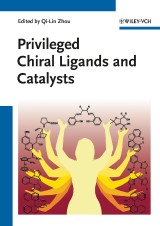Details

Privileged Chiral Ligands and Catalysts
1. Aufl.
|
156,99 € |
|
| Verlag: | Wiley-VCH |
| Format: | EPUB |
| Veröffentl.: | 10.02.2011 |
| ISBN/EAN: | 9783527635214 |
| Sprache: | englisch |
| Anzahl Seiten: | 484 |
DRM-geschütztes eBook, Sie benötigen z.B. Adobe Digital Editions und eine Adobe ID zum Lesen.
Beschreibungen
Catalytic asymmetric synthesis has been one of the most active research areas in chemistry (Nobel Prize in 2001). The development of efficient chiral catalysts plays a crucial role in asymmetric catalysis. Although many chiral ligands/catalysts have been developed in the past decades, the most efficient catalysts are derived from a few core structures, called "privileged chiral catalysts". This ultimate "must have" and long awaited reference for every chemist working in the field of asymmetric catalysis starts with the core structure of the catalysts, explaining why a certain ligand or catalyst is so successful. It describes in detail the history, the basic structural characteristics, and the applications of these "privileged catalysts". This novel presentation provides readers with a much deeper insight into the topic and makes it a must-have for organic chemists, catalytic chemists, chemists working with/on organometallics, chemists in industry, and libraries.<br> <br> From the contents:<br> * BINAP<br> * Bisphosphacycles - From DuPhos and BPE to a Diverse Set of Broadly Applied Ligands<br> * Josiphos Ligands: From Discovery to Technical Applications<br> * Chiral Spiro Ligands<br> * Chiral Bisoxazoline Ligands<br> * PHOX Ligands<br> * Chiral Salen Complexes<br> * BINOL<br> * TADDOLate Ligands<br> * Cinchona Alkaloids<br> * Proline Derivatives
Preface<br> BINAP<br> Introduction: Structural Consideration<br> Hydrogenation of Olefins<br> Hydrogenation of Ketones<br> Isomerization of Allylamines and Allylalcohols<br> Hydroboration, Hydrosilylation, Hydroacylation, and Hydroamination<br> Allylic Alkylation<br> Heck Reaction<br> Aldol and Mannich-Type Reactions<br> Nucleophilic Additions to Carbonyl and Imino Compounds<br> Alpha-Substitution Reactions of Carbonyl Compounds<br> Michael-Type Reactions<br> Conjugate Additions Using Organoboron and Grignard Reagents<br> Diels-Alder Reaction<br> Ene Reaction<br> Cyclization<br> Ring-Opening Reactions<br> Concluding Remarks<br> <br> BISPHOSPHACYCLES -<br> FROM DuPHOS AND BPE TO A DIVERSE SET OF BROADLY APPLIED LIGANDS<br> Introduction<br> Development of Bisphosphacycle Ligands<br> Applications of Bisphosphacycle Ligands<br> Concluding Remarks<br> <br> JOSIPHOS LIGANDS: FROM DISCOVERY TO TECHNICAL APPLICATIONS<br> Introduction and Background<br> Discovery and Development of the Josiphos Ligand Family<br> Why Are Josiphos Ligands So Effective?<br> Catalytic Profile of the Josiphos Ligand Family<br> Concluding Remarks<br> <br> CHIRAL SPIRO LIGANDS<br> Introduction<br> Preparation of Chiral Spiro Ligands<br> Asymmetric Hydrogenation<br> Asymmetric Carbon-Carbon Bond Forming Reaction<br> Asymmetric Carbon-Heteroatom Bond Forming Reaction<br> Conclusion<br> <br> CHIRAL BISOXAZOLINE LIGANDS<br> Introduction<br> Enantioselective Carbon-Carbon Bond Formation<br> Enantioselective Carbon-Heteroatom Bond Formation<br> Enantioselective Cycloaddition Reactions<br> Conclusions<br> <br> PHOX LIGANDS<br> Introduction<br> Synthesis of PHOX Ligands<br> Nucleophilic Allylic Substitution<br> Decarboxylative Tsuji Allylations<br> Heck Reaction<br> Hydrogenation<br> Cycloadditions<br> Miscellaneous Reactions<br> Conclusion<br> <br> CHIRAL SALEN COMPLEXES<br> Introduction<br> Synthesis of Chiral Salen Complexes<br> Structural Properties of Chiral Salen Complexes<br> Asymmetric Reactions Catalyzed by Chiral Salen Complexes<br> Conclusion and Outlook<br> <br> BINOL<br> Introduction<br> Applications in Reduction and Oxidation<br> Metal/BINOL Chiral Lewis Acid Catalysts in Asymmetric C-C Bond Forming Reactions<br> Acid/Base Bifunctional Metal/BINOL Catalysts<br> BINOL in Organocatalysis<br> Summary<br> <br> TADDOLATE LIGANDS<br> Introduction<br> Nucleophilic Additions to C=O Double Bonds<br> Nucleophilic Conjugate Additions to Electron-Deficient C=C Double Bonds<br> Nucleophilic Substitutions<br> Cycloaddition Reactions<br> Oxidation and Reduction Reactions<br> Miscellaneous Reactions<br> Conclusions<br> <br> CINCHONA ALKALOIDS<br> Introduction<br> Metal Catalysis<br> Phase-Transfer Catalysis<br> Nucleophilic Catalysis<br> Base Catalysis<br> Cooperative and Multifunctional Catalysis<br> Conclusion<br> <br> PROLINE DERIVATIVES<br> Introduction<br> Proline as Organocatalyst<br> Proline Analogs as Organocatalysts<br> 5-Pyrrolidin-2-yltetrazole as Organocatalyst<br> Pyrrolidine-Based Sulfonamides as Organocatalysts<br> Pyrrolidine-Based Amides as Organocatalysts<br> Pyrrolidine Diamine Catalysts<br> Diarylprolinols or Diarylprolinol Ether Catalysts<br> Concluding Remarks<br>
Qi-Lin Zhou is the Director of the Institute of Elemento-organic Chemistry, Nankai University in Tianjin, China. He obtained his PhD degree at Shanghai Institute of Organic Chemistry. After several years of postdoctoral research (with professors Andreas Pfaltz and Michael Doyle et al.) he started his independent research in the field of asymmetric catalysis in China. Qi-Lin Zhou has authored over 100 scientific publications and has received many scientific awards including the Prize for Creation in Organic Synthesis (Chinese Chemical Society, Division of Organic Chemistry), Yao-Zeng Huang Prize of Organometallics (Chinese Chemical Society), and JSPS Fellowship Award (Japan Society for the Promotion of Science). He is also a member of different editorial boards such as Acc. Chem. Res..
Catalytic asymmetric synthesis has been one of the most active research areas in chemistry (Nobel Prize in 2001). The development of efficient chiral catalysts plays a crucial role in asymmetric catalysis. Although many chiral ligands/catalysts have been developed in the past decades, the most efficient catalysts are derived from a few core structures, called "privileged chiral catalysts". This ultimate "must have" and long awaited reference for every chemist working in the field of asymmetric catalysis starts with the core structure of the catalysts, explaining why a certain ligand or catalyst is so successful. It describes in detail the history, the basic structural characteristics, and the applications of these "privileged catalysts". This novel presentation provides readers with a much deeper insight into the topic and makes it a must-have for organic chemists, catalytic chemists, chemists working with/on organometallics, chemists in industry, and libraries.<br> <br> From the contents:<br> * BINAP<br> * Bisphosphacycles - From DuPhos and BPE to a Diverse Set of Broadly Applied Ligands<br> * Josiphos Ligands: From Discovery to Technical Applications<br> * Chiral Spiro Ligands<br> * Chiral Bisoxazoline Ligands<br> * PHOX Ligands<br> * Chiral Salen Complexes<br> * BINOL<br> * TADDOLate Ligands<br> * Cinchona Alkaloids<br> * Proline Derivatives


















